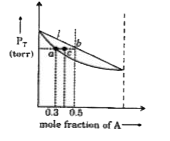Assertion : In any ionic solid [MX] with Schottky defects, the number of positive and negative ions are same.
Reason : Equal number of cation and anion vacancies are present. Solution in Malayalam
If both (A) and ( R) are correct and ( R) is the correct explanation of(A).
If both (A) and ( R) are correct, but ( R) is not the correct explanation of (A).
If (A) is correct, but ( R) is incorrect.
If both (A) and ( R) are incorrect.
The correct Answer is:A
Schottky defect is defined as a vacancy developed for anion and cation site, so cation and anion vacancy will be same in number. Therefore an ionic solid MX with Schottky defects will still have the same number of anions and cations.
Topper's Solved these Questions
- SOLID STATEBOOK - BRILLIANT PUBLICATIONCHAPTER - SOLID STATEEXERCISE - QUESTIONS
14 Videos
- SOLID STATEBOOK - BRILLIANT PUBLICATIONCHAPTER - SOLID STATEEXERCISE - LEVEL-1
50 Videos
- SOLID STATEBOOK - BRILLIANT PUBLICATIONCHAPTER - SOLID STATEEXERCISE - LEVEL-II
50 Videos
- REDOX REACTION & ELECTROCHEMISTRYBOOK - BRILLIANT PUBLICATIONCHAPTER - REDOX REACTION & ELECTROCHEMISTRYEXERCISE - QUESTION (ELECTROCHEMISTRY) (LEVEL -II) (ASSERTION-REASON)
3 Videos
- SOLUTIONSBOOK - BRILLIANT PUBLICATIONCHAPTER - SOLUTIONSEXERCISE - Level-III (Linked Comprehension Type)
12 Videos
Similar Questions
A compound of elements X and Y crystallizes in cubic structure where X atoms occupy the corners of the cube and Y atoms occupy the centre of the cube. What is the formula of the compound?
View SolutionThe radius of a di val ent cation M2+ is 94 pm and of divalent anion X2− is 146 pm. Thus, M2X2− has
View SolutionTotal number of voids in 0.5 mole of a compound forming hexagonal closed packed structure are
View SolutionAssertion: After the electrolysis of aqueous CuSO4 solution pH decreases.
Reason: Sulphuric acid is formed.
View Solution1 mole of A and 1 mole B are mixed together to form an ideal solution at 25∘C. Solution is placed in a vessel fitted with piston. If pressure on the solution is reduced isothermally.

Correct relationship between P∘AandP∘B is
View SolutionStatement I: In any ionic solid [MX] with Schottky defect, the number of positive and negative ions are same.
Statement II: An equal number of cation and anion vacancies is present.
View SolutionStatement 1: In any ionic solid [MX] withschotty defects, the number of positive and negative ions are same Statement 2: Equals number of cation and anion vacancies are present .
View SolutionAssertion (A) In any ionic solid (MX) with Schttky defects, the number of positive and negative ions is the same.
Reason(R)Equall number of cation and anion vacancies are present.
View SolutionStatement 1: In any ionic solid [MX] withschotty defects, the number of positive and negative ions are same
Statement 2: Equals number of cation and anion vacancies are present .
View SolutionStatement 1: In any ionic solid [MX] withschotty defects, the number of positive and negative ions are same
Statement 2: Equals number of cation and anion vacancies are present .
View SolutionIn the following question, a statement of assertion is followed by a statement of reason. Mark the correct choice.
Assertion : In any ionic solid [MX] with schottky defects, the number of positive and negative ions are same.
Reason : Equal number of cation and aniojn vacancies are present .
View SolutionAssertion : In Schottky defect, density of crystal decreases. Reason : Number of cations and anions are missing in Schottky defect are equal.
View SolutionAssertion : A crystal with schottky defect is electrically neutraly Reason : Equal number of cation and anion vacanies are present
View SolutionStatement I: In any ionic solid [MX] with Schottky defect, the number of positive and negative ions are same.
Statement II: An equal number of cation and anion vacancies is present.
View Solutionकथन -1 : कोणीय संवेग तथा प्लांक स्थिरांक विमीय रूप से समान होते हैं |
कथन -2 : विमीय रूप से समरूप राशियाँ समान होती हैं |
View Solution(A) In any ionic solid with Schottky defects the number of positive and negative ions is same. (R) Equal number of cation and anion vacancies are present
View Solution
